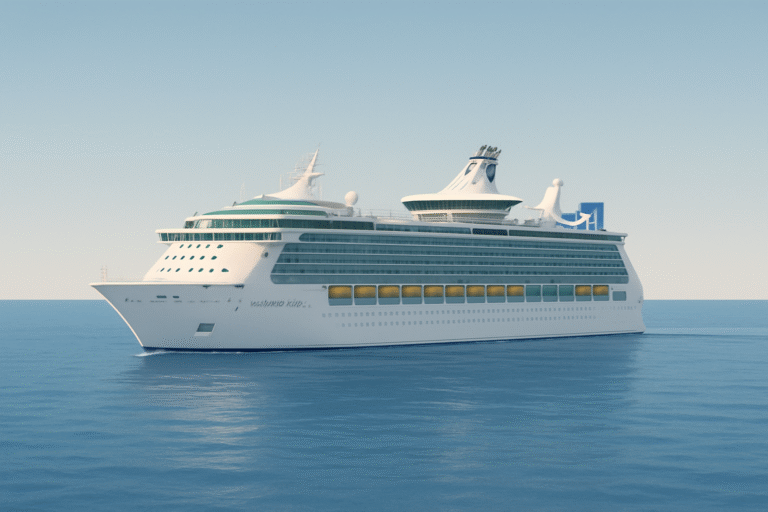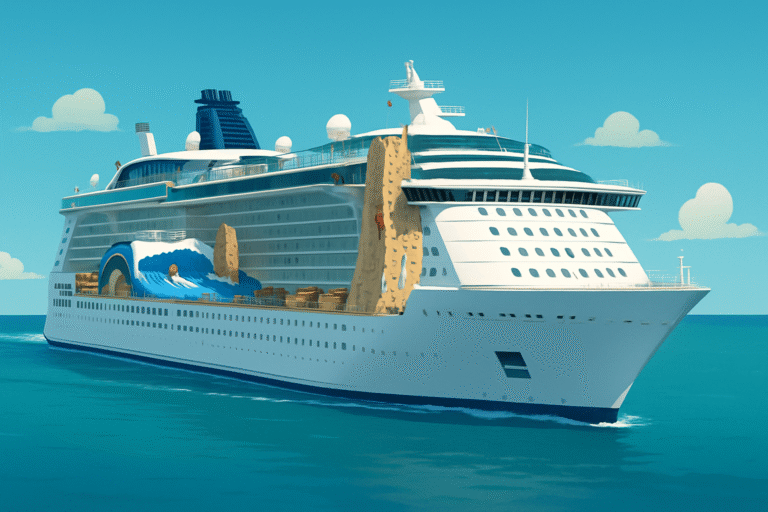
Introduction: A New Era of Cruising
The year 2006 marked a notable period of growth and transformation within the cruise industry. For seasoned voyagers and those newly curious about life at sea, it was a time of unprecedented choice. Major cruise lines introduced a fleet of new vessels, each promising a unique experience. These were not merely larger versions of their predecessors; they represented shifts in design philosophy, onboard amenities, and the very concept of a vacation at sea. This influx of modern ships signaled a new chapter, offering travelers more destinations, more activities, and more reasons to set sail.
The competition among lines spurred a remarkable burst of creativity. From ships designed to be the largest in the world to others focusing on intimate, culturally rich experiences, the class of 2006 brought something for every type of traveler. This was a year where the vessels themselves became destinations, packed with features designed to entertain, relax, and inspire passengers from the moment they stepped aboard.
Holland America’s Noordam: A Signature of Excellence
Holland America Line, a company with a long and storied history, introduced the Noordam in early 2006. Launched on February 22, this vessel was the final ship in the line’s celebrated Vista-class series. Yet, it was also a pioneer. The Noordam was the first ship constructed from the ground up to incorporate the principles of the line’s “Signature of Excellence” program, a fleet-wide initiative focused on refining the passenger experience through upgraded accommodations and enhanced public spaces.
With a capacity for 1,848 passengers, the Noordam maintained a relatively intimate feel compared to some of its contemporaries. It was built not to overwhelm with scale, but to impress with quality and thoughtful design.
Vista-Class Refinements
While sharing a blueprint with its sister ships, the Noordam featured distinct modifications. The design team focused its attention on areas where passengers gather and relax, making subtle but meaningful changes to staterooms and public lounges. The goal was to create an environment that felt both luxurious and comfortable, a home away from home on the waves. These refinements aimed to elevate the established Vista-class platform to a new standard of passenger comfort and convenience.
Enhancements to Public Areas and Staterooms
A prime example of the ship’s enhancements was the expansion of the Explorations Cafe. This popular spot was more than just a place to get coffee. It was a multi-functional hub that combined a coffee bar, an internet cafe, a well-stocked library, and a quiet area for games and puzzles. The design changes made this space even more inviting, solidifying its role as a central meeting point for guests. The attention to such details throughout the ship demonstrated Holland America’s commitment to a refined and passenger-centric cruising experience.
NCL’s Fleet Expansion
Norwegian Cruise Line (NCL) also made significant additions to its fleet in 2006, continuing to build upon its innovative “Freestyle Cruising” concept. This approach liberates passengers from traditional fixed dining times and formal dress codes, offering a more relaxed and flexible vacation. Two new ships, each with a distinct character, joined the NCL family.
The Pride of Hawaii: A Tribute to the Islands
Launched in June, the Pride of Hawaii was a purpose-built vessel for NCL America, designed specifically for inter-island Hawaiian itineraries. As a sister ship to the Norwegian Jewel, it shared a successful platform but was given its own unique identity. The ship was a landmark for the cruise line; it was the first vessel built entirely new, from the keel up, for its U.S.-flagged operations.
Accommodating 2,224 passengers, the ship’s interior was a celebration of its namesake. The decor was thoroughly Hawaiian, reflecting the culture, colors, and natural beauty of the islands it would call home. Departing weekly from its homeport of Honolulu on Mondays, the Pride of Hawaii offered a convenient and immersive way to experience the archipelago.
The Norwegian Pearl and the Bar Central Innovation
Later in the year, NCL prepared to launch the Norwegian Pearl. Set for a December debut, this ship was scheduled for a dual deployment, sailing to the warm waters of the Caribbean during the winter and venturing to the majestic landscapes of Alaska in the summer.
A key innovation aboard the Norwegian Pearl was the introduction of Bar Central.
This was a clever design concept that linked several distinct themed bars into one interconnected, flowing space. Passengers could easily move between a sophisticated martini bar, a celebratory champagne and wine bar, and a traditional beer and whiskey pub. This arrangement created a vibrant and social atmosphere, offering a variety of moods and drink menus within a single, convenient location on the ship.
Royal Caribbean’s Freedom of the Seas: The World’s Largest Ship

In May, Royal Caribbean International launched a vessel that captured global attention. The Freedom of the Seas was not just another new ship; it was a behemoth that reset the standard for size and onboard features in the cruise industry. It was immediately hailed as one of the most inventive ships the line had ever produced.
Record-Breaking Size and Capacity
The statistics were staggering for their time. At 158,000 gross tons, the Freedom of the Seas was significantly larger than any passenger ship afloat, even eclipsing the celebrated Queen Mary 2 by a margin of 10,000 tons. With a double-occupancy capacity of 3,600 passengers, it was a floating city designed for grand-scale adventure. Its sheer size allowed for the inclusion of amenities and public spaces that were previously unimaginable on a cruise ship.
Revolutionary Onboard Features
What truly set the Freedom of the Seas apart was its collection of unique attractions. The most talked-about feature was the FlowRider, a surf simulator located on the top deck that allowed passengers to ride waves at sea. This was a first for the industry.
It also featured the largest rock-climbing wall at sea, towering over the decks and offering breathtaking ocean views to successful climbers. These active, high-energy features demonstrated Royal Caribbean’s focus on providing a dynamic vacation experience that catered to families and thrill-seekers.
A New Home for Caribbean Adventure
After its inaugural events, the Freedom of the Seas was based in Miami. From there, it began a schedule of seven-day voyages through the Caribbean. Its size and amenities made it a perfect platform for island-hopping adventures, offering passengers a resort-like experience as they traveled between tropical ports of call.
The Crown Princess: A Redesigned Princess Experience
Princess Cruises christened its new ship, the Crown Princess, in a ceremony in June. This large vessel was designed to carry 3,110 passengers, attended by a crew of 1,200, continuing the line’s tradition of grand-style cruising. The ship was a modified version of its Grand-class sisters, incorporating new features and redesigning popular passenger areas.
Upgraded Lounges and Spas
Princess took feedback from its loyal passengers and made noticeable improvements to several venues. The Skywalker’s Nightclub, a signature lounge perched at the rear of the ship, was redesigned for better flow and atmosphere. The popular Lotus Spa was expanded, offering more treatment rooms and a larger thermal suite for relaxation. Other familiar spaces, like the nautical-themed Wheelhouse Bar, were also expanded to accommodate more guests comfortably.
New Culinary Venues
The Crown Princess introduced several new dining and snack options. A new International Cafe in the atrium served gourmet coffees, fresh pastries, and light snacks around the clock. A significant addition was the ship’s wine and seafood bar, a first for the Princess fleet, offering a sophisticated spot for light meals and fine vintages. Existing specialty restaurants, including Sabatini’s Trattoria and the Sterling Steakhouse, were also given more space, reflecting the growing demand for alternative dining experiences.
Sailing from New York to the Tropics
The Crown Princess was homeported in Red Hook, Brooklyn, offering a convenient departure point for travelers in the northeastern United States. From New York, it embarked on roundtrip cruises to a variety of sun-drenched destinations, including Bermuda, the Turks and Caicos, and ports throughout the Eastern Caribbean.
MSC Musica: An Italian Entry into the Big Leagues
On July 1, the Italian cruise line MSC Cruises launched the MSC Musica. This vessel represented a significant step for the company, moving it firmly into the category of large, modern cruise ship operators. The ship, designed to accommodate 2,550 passengers, blended contemporary amenities with a distinct Italian flair.
A Focus on Ocean Views and Balconies
A standout feature of the MSC Musica’s design was its dedication to providing passengers with a connection to the sea. An impressive 80 percent of its 1,275 staterooms were outside cabins with an ocean view. Further to this point, a remarkable 65 percent of all cabins featured private balconies. This design choice underscored a commitment to providing guests with their own private space to enjoy the seascapes.
Waterfalls and Entertainment at Sea
The ship’s central lobby was dominated by a stunning three-deck-high waterfall, creating a dramatic and elegant first impression. The vessel was equipped with a large, tranquil spa area for passengers seeking rejuvenation. It also offered guests several different dining choices, from formal restaurants to casual eateries, along with a wide range of entertainment venues, including a large theater and multiple bars and lounges. The MSC Musica spent its inaugural season sailing seven-night itineraries in the Eastern Mediterranean, departing from the historic port of Venice.
Costa Concordia: European Style on the Waves
Another major European debut in 2006 came from Costa Cruises. The Costa Concordia, launched on July 14, became the largest ship in the Italian line’s fleet. While Costa is based in Italy, it is part of the Miami-based Carnival Corporation, and the new ship reflected this blend of European style and large-scale American cruising. It had a capacity for 3,000 passengers.
A Uniquely Themed Interior
The interior of the Costa Concordia was a tribute to the continent of Europe. Public rooms and decks were named after famous European cities and concepts, creating a cohesive and cultured atmosphere. Guests could enjoy a drink in the Grand Bar Berlin, grab a coffee at the Cafeteria Helsinki, or dine in the grand Milan and Rome main dining rooms. This thematic approach gave the ship a distinct personality.
Exclusive Amenities like the F1 Simulator
One of the ship’s most unusual and exclusive amenities was a Formula 1 racing simulator. This high-tech attraction allowed passengers to experience the thrill of grand prix racing while at sea, an offering that was unique in the industry at the time. It provided a one-of-a-kind entertainment option that appealed to guests of all ages.
Year-Round Mediterranean Voyages
The Costa Concordia was deployed for year-round service in the Western Mediterranean. Its itineraries included a wide range of popular ports, with calls in Spain, France, Italy, Gibraltar, and Malta. This allowed travelers to experience some of Europe’s most historic and beautiful coastlines from the comfort of a new, state-of-the-art vessel.
Conclusion: The Lasting Impact of a New Generation of Ships
The class of 2006 was more than just a collection of new cruise ships. It represented a pivotal moment, showcasing an industry pushing the boundaries of engineering, design, and entertainment. From the world’s largest ship packed with active adventures to elegantly appointed vessels focused on culinary arts and ocean views, this new generation had a profound effect. They broadened the appeal of cruising, solidified new concepts like flexible dining, and introduced a host of onboard activities that are now commonplace. This wave of innovation provided travelers with a remarkable spectrum of choices and set a new benchmark for what a vacation at sea could be.